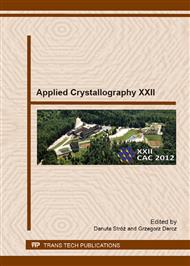p.343
p.347
p.351
p.355
p.361
p.368
p.372
p.376
p.380
Microstructure of the Fe-Ni-P Melt-Spun Ribbons Produced from the Single-Chamber and from the Double-Chamber Crucibles
Abstract:
The aim of the work was to investigate the influence of the processing on the final microstructure of the melt-spun Ni-Fe-P ribbons. The melt-spinning was carried out in two ways. For the first one the alloy was molten in a simple single-chamber crucible and for the second one double-chamber crucible was used. The chemical composition of the alloy molten in the single chamber was Ni40Fe40P20. The two component melt-spinning was made starting from the Ni80P20 and Fe80P20 alloys. All of the three alloys were molten in titanium gettered argon atmosphere starting from 99.95 wt % Ni, 99.95 wt % Fe, Ni-P and Fe-P master alloys in the arc melting furnace. The alloys were melt-spun in helium. The phase composition and the microstructure of the melt-spun ribbons were investigated by X-ray diffraction (XRD), a transmission electron microscope (TEM), respectively. The fracture of the specimens were observed with use of scanning electron microscope (SEM). SEM observations of the fracture surfaces show different character of the fractured samples.
Info:
Periodical:
Pages:
361-367
Citation:
Online since:
June 2013
Authors:
Price:
Сopyright:
© 2013 Trans Tech Publications Ltd. All Rights Reserved
Share:
Citation:


